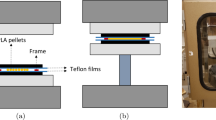Abstract
This study describes the synthesis of poly(N-isopropylacrylamide) (PNIPAM) via free radical polymerization, the preparation of physical blends containing sodium carboxymethylcellulose (CMC) and PNIPAM in aqueous solution, at total polymer concentrations of 2 and 6 g/L in different compositions, and applies rheology to investigate interactions between PNIPAM and CMC compared to pure polymers, in aqueous solution. Rheological measurements indicated thermothickening behavior for the 50 % PNIPAM–50 % CMC physical blend in aqueous solution, at 6 g/L, as viscosity rose when temperature was increased to a range of 25–40 °C. Similar thermothickening behavior was observed for the 25 % CMC–75 % PNIPAM physical blend in solution, at a total polymer concentration of 2 g/L. These results provide new information for preparing physical blends in aqueous solutions exhibiting thermothickening behavior, indicating that this behavior depends on total polymer concentration and composition of the mixture.


Similar content being viewed by others
References
Shi HY, Zhang LM, Ma YQ, Yi JZ (2007) Synthesis and characterization of water-soluble cellulose derivatives with thermo- and pH-sensitive functional groups. J Macromol Sci Part A 44:1109–1113. doi:10.1080/10601320701524179
Vasile C, Bumbu GG, Dumitriu RP, Staikos G (2004) Comparative study of the behavior of carboxymethyl cellulose-g-poly(N-isopropylacrylamide) copolymers and their equivalent physical blends. Eur Polym J 40:1209–1215. doi:10.1016/j.eurpolymj.2003.12.023
Chee CK, Rimmer S, Soutar I, Swanson L (2001) Fluorescence investigations of the thermally induced conformational transition of poly(N-isopropylacrylamide). Polymer 42:5079–5087. doi:10.1016/S0032-3861(00)00821-1
Gao C, Möhwald H, Shen J (2005) Thermosensitive poly(allylamine)-g-poly(N-isopropylacrylamide): synthesis, phase separation and particle formation. Polymer 46:4088–4097. doi:10.1016/j.polymer.2005.02.115
Schmaljohann D (2006) Thermo- and pH-responsive polymers in drug delivery. Adv Drug Deliv Rev 58:1655–1670. doi:10.1016/j.addr.2006.09.020
Dimitrov I, Trzebicka B, Müller AHE, Dworak A, Tsvetanov CB (2007) Thermosensitive water-soluble copolymers with doubly responsive reversibly interacting entities. Prog Polym Sci 32:1275–1343. doi:10.1016/j.progpolymsci.2007.07.001
O’Shea J-P, Tallon C (2011) Yield stress behaviour of concentrated silica suspensions with temperature-responsive polymers. Colloids Surf A 385:40–46. doi:10.1016/j.colsurfa.2011.05.042
Lin SY, Chen KS, Liang RS (1999) Thermal micro ATR/FT-IR spectroscopic system for quantitative study of the molecular structure of poly(N-isopropylacrylamide) in water. Polymer 40:2619–2624. doi:10.1016/S0032-3861(98)00512-6
Burdukova E, Li H, Bradshaw DJ, Franks GV (2010) Poly(N-isopropylacrylamide) (PNIPAM) as a flotation collector: effect of temperature and molecular weight. Miner Eng 23:921–927. doi:10.1016/j.mineng.2010.03.003
Bokias G, Mylonas Y, Staikos G, Bumbu GG, Vasile C (2001) Synthesis and aqueous solution properties of novel thermoresponsive graft copolymers based on a carboxymethylcellulose backbone. Macromolecules 34:4958–4964. doi:10.1021/ma010154e
Charpentier D, Mocanu G, Carpov A, Chapelle S, Merle L, Muller G (1997) New hydrophobically modified carboxymethycellulose derivatives. Carbohydr Polym 33:177–186. doi:10.1016/S0144-8617(97)00031-3
Guillot S, Delsanti M, Désert S, Langevin D (2003) Surfactant-induced collapse of polymer chains and monodisperse growth of aggregates near the precipitation boundary in carboxymethylcellulose-DTAB aqueous solutions. Langmuir 19:230–237. doi:10.1021/la0206561
Lin OH, Kumar RN, Rozman HD, Noor MAM (2005) Grafting of sodium carboxymethylcellulose (CMC) with glycidyl methacrylate and development of UV curable coating from CMC-g-GMA induced by cationic photoinitiators. Carbohydr Polym 59:57–69. doi:10.1016/j.carbpol.2004.08.027
Moura MR, Rubira AF, Muniz EC (2008) Hidrogéis semi-IPN baseados em rede de alginato-Ca2+ com PNIPAAm entrelaçado: propriedades hidrofílicas, morfológicas e mecânicas. Polim Cienc Tecnol 18:132–137. doi:10.1590/S0104-14282008000200010
Marques NN, Maia AMS, Curti PS, Balaban RC (2010) Efeito da temperatura de síntese sobre a massa molar do polímero termossensível poli(N-isopropilacrilamida). Livro eletrônico—Anais/Resumos da 62a Reunião Anual da SBPC. http://www.sbpcnet.org.br/livro/62ra/resumos/resumos/2891.htm. Accessed 10 Nov 2011
Harding SE (1997) The intrinsic viscosity of biological macromolecules. Progress in measurement, interpretation and application to structure in dilute solution. Prog Biophys Mol Biol 68:207–262. doi:10.1016/S0079-6107(97)00027-8
Muniz EC, Geuskens G (2001) Compressive elastic modulus of polyacrylamide hydrogels and semi-IPNs with poly(N-isopropylacrylamide). Macromolecules 34:4480–4484. doi:10.1021/ma001192l
Vidal RRL, Balaban R, Borsali R (2008) Amphiphilic derivatives of carboxymethylcellulose: evidence for intra- and intermolecular hydrophobic associations in aqueous solutions. Polym Eng Sci 48:2011–2026. doi:10.1002/pen.21180
Tam KC, Wu XY, Pelton RH (1992) Viscosimetry—a useful tool for studying conformational changes of poly(N-isopropylacrylamide) in solutions. Polymer 33:436–438. doi:10.1016/0032-3861(92)91008-P
Zhang X, Zhou L, Zhang X, Dai H (2010) Synthesis and solution properties of temperature-sensitive copolymers based on NIPAM. J Appl Pol Sci 116:1099–1105. doi:10.1002/app.31574
Bajpai A, Shukla S, Saini R, Tiwari A (2010) Stimuli responsive drug delivery systems: from introduction to application. In: Temperature-sensitive release systems. iSmithers, Shawbury, pp 107–112
Aguilar MR, Elvira C, Gallardo A, Vázquez B, Román JS (2007) Smart polymers and their applications as biomaterials, chap 6. In: Ashammakhi N, Reis R, Chiellini E (eds) Topics in tissue engineering, vol 3., pp 1–23
Bokias G, Hourdet D, IIiopoulos I, Staikos G, Audebert R (1997) Hydrophobic interactions of poly(N-isopropylacrylamide) with hydrophobically modified poly(sodium acrylate) in aqueous solution. Macromolecules 30:8293–8297. doi:10.1021/ma970884f
Acknowledgments
The authors thank the PRH30/ANP/MCT, PETROBRAS and CAPES—an entity of the Brazilian Government directed toward the training of human resources—for their financial support.
Author information
Authors and Affiliations
Corresponding author
Rights and permissions
About this article
Cite this article
de Lima, B.V., Vidal, R.R.L., do N. Marques, N. et al. Temperature-induced thickening of sodium carboxymethylcellulose and poly(N-isopropylacrylamide) physical blends in aqueous solution. Polym. Bull. 69, 1093–1101 (2012). https://doi.org/10.1007/s00289-012-0813-z
Received:
Revised:
Accepted:
Published:
Issue Date:
DOI: https://doi.org/10.1007/s00289-012-0813-z




